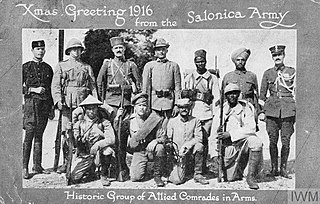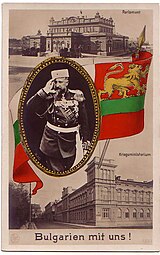The Bulgarian First Army was a Bulgarian field army during the Balkan Wars, World War I and World War II.

The Battle of Kilkis–Lachanas took place between Greece and Bulgaria during the Second Balkan War. The two countries fought for the town of Kilkis in Central Macedonia from 19 to 21 June 1913 O.S. with Greece ultimately being victorious.

The Battle of Skra-di-Legen was a two-day battle which took place at the Skra fortified position, located northeast of Mount Paiko, which is north-west of Thessaloniki, on May 29–30, 1918, on the Macedonian front of World War I. The battle was the first large-scale employment on the front of Greek troops of the National Defense Army Corps, and resulted in the elimination of a whole enemy regiment and the capture of the heavily fortified Bulgarian positions.
The 22nd Division was an infantry division of the British Army during World War I, raised in September 1914, from men volunteering for Lord Kitchener's New Armies. The division moved to France in September 1915, but it was transferred to Greece only one month later. It served in the Balkans Campaign for the duration of the First World War.

The Macedonian front, also known as the Salonica front, was a military theatre of World War I formed as a result of an attempt by the Allied Powers to aid Serbia, in the autumn of 1915, against the combined attack of Germany, Austria-Hungary and Bulgaria. The expedition came too late and with insufficient force to prevent the fall of Serbia and was complicated by the internal political crisis in Greece. Eventually, a stable front was established, running from the Albanian Adriatic coast to the Struma River, pitting a multinational Allied force against the Bulgarian army, which was at various times bolstered with smaller units from the other Central Powers. The Macedonian front remained stable, despite local actions, until the Allied offensive in September 1918 resulted in Bulgaria capitulating and the liberation of Serbia.

The Battle of Dobro Pole, also known as the Breakthrough at Dobro Pole, was a World War I battle fought between 15 and 18 September 1918. The battle was fought in the initial stage of the Vardar Offensive, in the Balkans Theatre. On 15 September, a combined force of Serbian, French and Greek troops attacked the Bulgarian-held trenches in Dobro Pole, at the time part of the Kingdom of Serbia. The offensive and the preceding artillery preparation had devastating effects on Bulgarian morale, eventually leading to mass desertions.

Vladimir Minchev Vazov was a Bulgarian officer. He led the Bulgarian forces during the successful defensive operation at Dojran during the First World War.

The Bulgarian Land Forces are the ground warfare branch of the Bulgarian Armed Forces. It is administered by the Ministry of Defence, previously known as the Ministry of War during the Kingdom of Bulgaria. The Land Forces were established in 1878, when they were composed of anti-Ottoman militia (opalchentsi) and were the only branch of the Bulgarian military.
The 26th Division was an infantry division of the British Army during World War I. The division was created in September 1914 from men volunteering for Lord Kitchener's New Armies and was the last division to be raised under the K3 enlistment scheme. Although the 26th Division began to assemble in September 1914, it was not fully deployed on the Western Front until the following year. In November 1915, the division was redeployed to the Macedonian Front, where it remained until the end of the war.

The Battle of Doiran was a 1917 battle between the United Kingdom and Bulgaria during World War I. The battle ended in decisive Bulgarian victory, leading to 16 months of silence on the front before the Third Battle of Doiran.
The Surrey Yeomanry was a unit of the British Army first formed as volunteer cavalry in 1794. It was reformed in 1901 and saw varied service in the First World War. During the interwar period, it converted to artillery and during the Second World War one of its regiments distinguished itself during the retreat to Dunkirk, saw action during the Second Battle of El Alamein, and also saw service in Sicily and Italy. Its other regiment served in East Africa, the Siege of Tobruk, and in Iraq and Persia. The regiment's lineage is maintained today by 2 Field Troop, 579 Field Squadron (EOD), part of 101 (London) Engineer Regiment (Volunteers).

XII Corps was an army corps of the British Army that fought in the First and Second World Wars. In the First World War, it formed part of the British Salonika Force on the Macedonian front. In the Second World War, it formed part of the British Second Army during Operation Overlord and the subsequent North-West Europe Campaign of 1944-46.
Lieutenant-General Sir Henry Fuller Maitland Wilson was a British Army officer who, throughout his long military career which spanned over four decades, served in the Second Anglo-Afghan War, the Second Boer War and the First World War, during which he served with distinction, commanding a division on the Western Front and an army corps in the lesser-known Salonikan campaign.
The Bulgarian Second Army was a Bulgarian field army during the Balkan Wars, World War I, and World War II.

The Vardar offensive was a World War I military operation, fought between 15 and 29 September 1918. The operation took place during the final stage of the Balkans Campaign. On September 15, a combined force of Serbian, French and Greek troops attacked the Bulgarian-held trenches in Dobro Pole, at the time part of Serbia. The assault and the preceding artillery preparation had devastating effects on Bulgarian morale, eventually leading to mass desertions.

The Struma operation was the occupation of a part of northeastern mainland Greece by the Bulgarian army during the First World War between 17–23 August 1916. It was named after the Struma (Strymonas) river.
The 302nd Division was an infantry division of the German Army. It was formed during World War I, as part of the 11th German-Bulgarian Army, combining members of both nationalities and saw service on the Macedonian front. During this time it fought major battles at Crna Bend and the Vardar Offensive. It was dissolved on 30 September 1918, in the aftermath of the capitulation of the 11th German-Bulgarian Army.
57th Infantry Division was an infantry division of the French Army during the First World War. It was deployed overseas, seeing action on the Salonika front, fighting alongside British troops. It was sent to the Crimea in December 1918 as part of the Army of the Danube.

134th Siege Battery was a heavy howitzer unit of Britain's Royal Garrison Artillery (RGA) raised during World War I. It saw active service at Salonika and in Palestine.
17th Colonial Infantry Division was an infantry division of the French Army during the First World War. It was deployed overseas, seeing action during the Gallipoli campaign, and thereafter on the Salonika front, fighting alongside British troops in both theatres of war. It was sent to the Crimea in December 1918 as part of the Army of the Danube.













